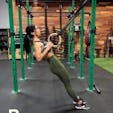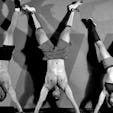There is nothing like the feeling of reaching down, wrapping your hands around a cold steel bar as you set your position, holding your breath, and pull the iron from the floor. Olympic lifting is one of the best ways to develop explosive power and strength; it is also an incredibly demanding practice both physically and mentally.
As with all challenging movement disciplines, we can improve our skills by complimenting them with others. In my own practice I have found bodyweight training and in particular single leg strength and Handstands to be one of the best compliments to my Olympic training.
WARNING: HANDSTANDS ARE HIGHLY ADDICTIVE!!! Before you read on you have been warned. What I am about to give you is more than a couple great Olympic supplemental drills like Jumping Good Mornings or Jerks from the Rack. Handstands truly are an addictive practice and an obsessive one. If you are ready to commit fully to this adventure, read on.
Handstands are more than a great supplement to your weight training, they are great for your health. Training inverted while balancing on your hands will help with circulation issues and correct muscle imbalances in your body.
They can also be a source of meditation and help mental focus. By flipping yourself upside down and learning to be strong there, you will increase your overhead lifting power and stability as you tackle the demands of the Olympic lifts.
In this article, I will walk you through the ways in which a daily handstand practice can better your lifting stability and give you more strength overall. Where there is more stability and strength, there is more potential for power! I will map out progressions for you to start your own handstand practice.
![Onnit Steel Mace]() Reason #1: Handstands Increase Grip Strength
Reason #1: Handstands Increase Grip Strength
If you want hands like the Hulk, start using them like feet. Think about how strong your feet and legs are from standing around on the mall day. If you want hands,arms,and shoulders of steel, spend more time using your hands like your feet and you will be amazed at the results.
When you squat, your feet have to help stabilize you; they are your base of sup- port and everything that happens above is dependent on how strong your foundation is. They are the first contact point with the floor. If your stability is lacking here, the entire structure of the squat or handstand will suffer. If your medial foot arches are lazy, then you will end up with inward knocking knees.
This “Effiel Tower Squat” will then lead to poor adductor development and then most likely lazy glutes resulting in lifting with your back and arms. Your feet can leak more than half the power you could potentially have for a lift, not to mention that it will lead to injury once the weight gets to be significant enough.
The same applies to your hands. You need to constantly be re-balancing from the arches in your hands. Otherwise you are working inefficiently as you try to hold your handstand and you will tire fast.
Before you beg in your Handstand practice, you must first spend some time preparing your joints and strengthening your hands. If that desk job of yours hasn’t given you hands of stone, this fun little push up variation will.
Handstand Progression: Wrist Push Ups
These beauties are a great way to get you in the right direction to gaining more stability and strength in your hands and forearms and help prevent wrist injuries while lifting. I first learned these from Shawn Mozen; this is just one of the torturous ways he grew up learning and teaching stability and strength in the hands and forearms for martial arts.
Start on all fours with your hands placed under your shoulders. Fingers forward, keep your shoulders protracted and depressed. Next, lift the heel of your palms off the ground, raising them up as high as you can. Lower them slowly to the ground but do not give your weight in to the ground. Simply kiss it with the heel of your palms and repeat.
For a more advanced version, bring your knees further behind your hands until you can do it from a push up position. Proceed slowly in these exercises. Less is more sometimes. Try to perform 3 sets of 10, but if your wrists are screaming at you like you are going to injure yourself,ease off the pressure by scaling the load back or reducing the reps.
Reason #2: Handstands Develop Amazing Stability in Overhead Barbell Positions
Handstand training is about endurance and the ability to isolate specific areas of your body with the flip of a switch. It is this constant re-connecting and then ability to control isolated areas of your muscle groups that will keep you in the Handstand and allow you to change shapes if you choose.
To get the most out of your Handstand you want to be as efficient as possible in this. Again, we will start with the hands as the contact point of the floor and work our way up throughout the body. Think of it as your Overhead Squat, Jerk, or Snatch, just upside down.
A great exercise for both Olympic lifting and pressing to handstand is The Cat. It will no doubt build more joint stability in the wrists, elbows, and shoulders and more importantly, start to help reinforce the connection of the anterior chain, a must if you want to someday lift like Alexander Varbanov.
Handstand Progression: The Cat
I have to give a shout out to my hand balancing coach Andralyn Zayn for this gem (insert face of pain here). Start on all fours with your hands under your shoulders, fingers tips forward and the eye of your elbows facing forward away from you.
Next press forward to bring the eye of the elbows further over your hands. This will ensure you are keeping external rotation in your shoulders, which will give you more lower lat engagement and help you stabilize in overhead positions.
Yes, it will be a sensory rich experience for the elbows but this will also help to build density in the muscles surrounding the joints to bulletproof against any hyperextension you may have at present and help prevent injuries. Or, if you are of the not-so-flexible nature, it will be one hell of a stretch.
Next, tuck your ribs in and protract your scapula like an angry cat. Pressing into the ground with your hands, keeping an outward spiral in the elbows and the angry cat back, lift yourself off the ground until just the tip of your toes are touching.
The aim is to get your wrists, shoulders, and ribs stacking over each other in one perfect line. This exercise is best done for isometric sets. You could try tabata rounds for beginners, working your way up to three,1minute rounds.
Reason #3: Increases Mental Focus and Capacity
Your hands shake, your arms tremble, you gasp for air as every muscle in your body tightens to maintain your position. Close your eyes and imagine how it feels? Are you imagining a handstand or the lockout of a Clean & Jerk? If you visualize the lift and imagine your body connecting through each and every nuance of the movement, the lift will be earth shattering.
If you approach a handstand or an Olympic lift without intent and focus, neither outcome will be what you want. Power and grace are not only the result of physical preparation but also mental. Handstands build your mental focus as it is a new direction for your body to have to find connection and balance.
You must be in a constant state of awareness in what your body is doing. A constant state of coordinating your muscles and re-balancing or you will fall. A lazy finger may cost you balance in a handstand just as a split second loss of focus could cost you a max lift.
Reason #4: Handstands Aid in Preventing Back Injuries
Handstands help build stronger anterior chain connection, a must if you are going to be hitting more and more PR’s in heavy lifting. One of the most common power leaks in lifting comes from losing anterior chain connection in the bottom of the squat.
This leads to the posterior chain having to work overtime and you end up posting the load off your spine, rather then getting the aid of the surrounding muscles of your entire trunk. By having more intention in keeping your ribs from popping forward, you reinforce a better spinal position in the bottom of your squat. This in turn forces you to work on activating the pelvic floor, diaphragm, multifidus, and transverse abdominals, a powerful corset of stability for you to gain more stability in your squats.
Activating the corset muscles will help you avoid injury to your lumbar spine and in turn prevent you from leaking power driving out of the bottom position. Not to mention, if your spine is inline it may expose some mobility issues that you could potentially have in your hip flexion and calve extension.
Handstand Progression: Back Holds
The Handstand is one of the most important positions to practice if you want to get stronger overall, but it doesn’t stop there. The Hollow Body connection is challenging in many ways, think of handstands, planches, front and back lever…etc. Hollow body and back holds are the basic positions you will want to start to play with before moving onto more complex practices.
Handstand Progression: Hollow Body
Start by lying on your back on the floor. Ribs in, butt squeezed, and hips externally rotated, forcing your legs to stay together. You want only your lumbar spine to touch, nothing else. For a more advanced version, have your arms overhead and rock quickly back and fourth. For an easier version, arms in front with legs
Handstand Progression: Hollow Back Holds
Lie on your stomach, arms overhead and legs together. Lift everything off the ground so that only your hips are contacting. If you are more advanced, rock this position back and fourth. Try both of these exercises for a tabata round or 5 rounds of 1-minute with a 1 minute rest in between.
Reason #5: Helps Correct Muscle Imbalances in the Spine & Legs
Training to hold a strict, legs together hand- stand is great for waking up gluteal amnesia and working the adductors in your legs, which will help reduce back pain. When you train these muscle groups to do their part in supporting your foundation in movements such as squatting, single leg strength, and handstands, you increase stability and strength to lift heavier and heavier loads.
Handstand Progression: Hollow Back Holds
Start from lying down with your stomach on the floor, arms over your head. Keeping your legs together and maintain- ing your hollow body position, start to walk your feet up the wall. Keeping your legs firmly together will get you to engage your glutes more, especially the external rotators and the adductors in your legs.
Go as high as you can with good form and do isometric holds. Putting a sponge between your tights, calves, or ankles for more of a challenge to engage these muscles is always fun! The latter is the more difficult.
To get the most out of this exercise, try doing endurance sets of 3-5 minutes. Hold for max time each set and rest the same amount before your next set. Example if you hold 2:15, rest 2:15, hold 1:00, rest 1:00, hold 45 seconds, rest 45 seconds until you accumulated the overall goal time you have chosen.
Reason #6: Handstands Prevent Injury in the Wrists, Elbows, & Shoulders
When practicing handstands, you are spend- ing so much time on your hands that the muscular endurance in your body really starts to develop quickly. In particular, the wrists, elbows, and shoulders develop, all great supporters for your overhead barbell position in Olympic Lifting. By increasing muscular endurance in the surrounding tissues of these joints, you are helping to build up the density in the them.
This will of course help prepare the wrists, elbows, and shoulders to be able to take more load with a barbell and minimize the potential for injuries. Two of my favorite shoulder stability exercises that help with your overhead position are Shoulder Flexion and Lower Lat Presses.
They will help build a lot of shoulder stability in particular. I was introduced to these by my circus coach Sean Lind. In both of these presses, you are looking to keep elevated and externally rotated shoulders. The cues to remember here are “eye of the elbow forward” and “shoulder ear muffs.”
Handstand Progression: Shoulder Flexion Presses
For beginners, start on a low box and progress to getting higher as the months go by until you can perform this in a hollow body position against the wall. Start with your feet on the box and your hands on the floor under your shoulders.
You may bend at the waist to make it easier at first, but you will want to train yourself to a hollow body gradually. Without bending your arms, bring your body forward until your shoulders are past your wrists. Hold for a few seconds and then press back to your start position.
Handstand Progression: Lower Lat Presses
Beginners can do Lat Pulldowns on a cable machine or with an resistance band. Make sure keep your wrist straight at all times to really isolate using as much of the lower lat as possible and not your upper traps.
Next, start above shoulder height, keeping your arms straight with shoulders externally rotated, retracted, and depressed. Pull your hands past your hip, hold for a few seconds and slowly resist the cable bringing your arm back to start position.
A more advanced variation would be to perform lower lat presses against the wall, facing away from it. Start in a handstand position with your finger tips close to the wall.
Keeping your legs together and toes pointed, support your butt and legs against the wall. Make sure you tuck your ribs tight throughout the exercise.
Chin to chest, press your shoulders back to touch the wall as you maintain full scapula elevation.
Mental Checklist For the Handstand
Here is a mental check list to keep thinking of while you are holding a handstand. Keep your breath clam, keep your focus sharp, and keep re-connecting. Start from point of contact with floor, active fingers and hands. Also check out this article about other handstand progressions.
- Keep weight forward in your hands (think wrist push ups)
- Eye of the elbows forward (to externally rotated shoulders)
- Shoulders elevated (push like hell to cover your ears, like you are driving out of the bottom of a heavy Snatch)
- Ribs tucked to engage the anterior chain more and have more stability throughout your body. (use your corset muscles)
- Hips open and externally rotated (squeeze your butt)
- Legs together (aka adductor hell)
- Toes pointed (to the moon, every part of the body is connected)
Finding new ways to solve old problems is what makes champions. If you want to improve your iron game, take a look at your bodyweight training. Adding handstands and other bodyweight skills will improve your kinesthetic awareness, strengthen your weak links, and sharpen your mental focus. Remember, if you can’t overcome the resistance in your own body, how are you going to master the forces of an external tool like a barbell?
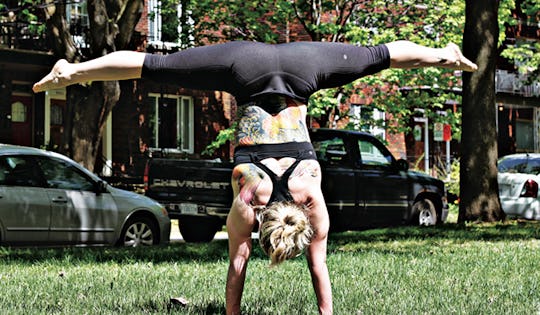


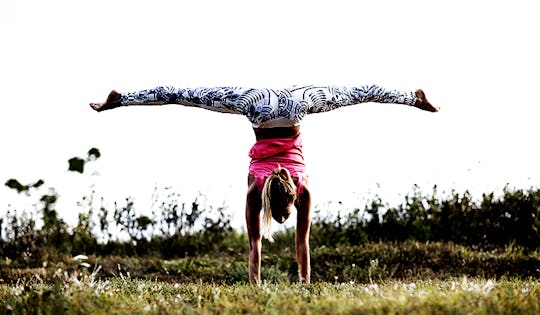
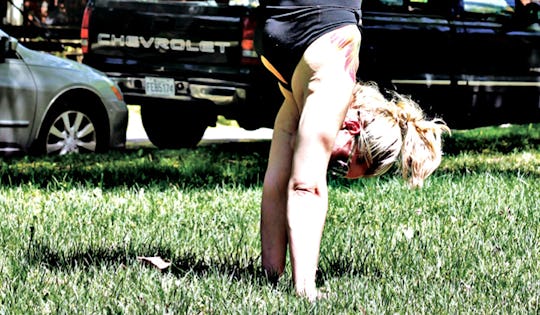
)

